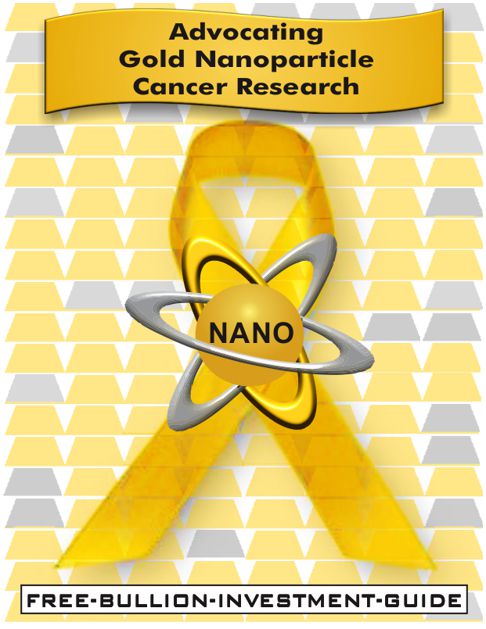Gold-Nano Blog / Gold Nanoparticle Cancer Research Report #10`
Gold Nanoparticle Cancer Research Report
#10
Originally Posted on 09/12/2018 @ 4:45 pm EDT
Last Edited 04/04/2025
by Steven Warrenfeltz
To be the first to receive this guide's blog posts
Subscribe to this Blog
Hello,
Gold Nanoparticle Cancer Research is a non-invasive cancer treatment that kills cancer without harmful side-effects.
Gold nanoparticles are inert, and research studies have demonstrated that they can be engineered to specifically target and destroy cancer cells, ensuring there are no life-threatening side effects associated with this approach.
Gold Nanoparticle Cancer Research has repeatedly shown, in study after study, that it should be one of the 21st century's better ways of treating cancer.
In this report, you'll find summaries of the most promising and compelling studies from the past two months (July & August 2018); with each summary, you'll find direct links to the original articles and/or research reports.
Below is a glimpse into what you'll find in this issue:
- Gold Nanoparticles Transport Gene-Altering Molecules to Fight Pancreatic Cancer Cells
- Gold Nano-Rods and Infrared Light Stop Cancer from Metastasizing
- Scientist design Cancer Fighting Gold Nano-Stars
Gold Nanoparticles Transport Gene-Altering Molecules to Fight Pancreatic Cancer Cells
Pancreatic Ductal Adenocarcinoma (PDAC) is the most common form of Pancreatic Cancer that is highly aggressive and difficult to treat.
Despite advancements in understanding the biology of pancreatic ductal adenocarcinoma (PDAC), the prognosis for this type of cancer remains poor. Typically, 80-90% of patients are considered surgically incurable, primarily because the disease is often diagnosed at later stages.
Pancreatic Ductal Adenocarcinoma (PDAC) tumors defend themselves against their host by creating a fibrous tissue that restricts blood flow, which helps it to spread to other areas of the body.
The traditional chemotherapy for pancreatic cancer is a drug called Gemcitabine, but due to the strong defenses of pancreatic cancer, this drug often barely makes a dent in killing the cancer cells.
That is why researchers at the University of Chinese Academy of Sciences in Beijing, China, have designed a new way of attacking Pancreatic Cancer (PDAC).
In the study, researchers designed a pH-responsive gold-based nanosystem that re-educates cancer cells to help the chemotherapy drug Gemcitabine work better.
The first graphic below shows how the researchers constructed the multi-layered gold nanoparticles.
From left to right, the gold nanoparticle is first coated with an acid (MUA) and two polymers (mPEG-d-PEI) that help to make the nanoparticles more stable in liquid.
Next, a non-chemotherapy drug called All-Trans-Retinoic Acid (ATRA) is added to the nanoparticle to "re-educate" the nucleus of the cancer cell to make it stop the production of its fibrous defenses.
The last stage of the gold nanoparticle-based system consisted of adding a protein called 'HSP47' (Heat-Shock Protein 47) and siRNA (small interfering RNA). These two molecules were added to help break up the cancer cell's defenses so that blood flow and drug absorption could be restored.
After the multi-layered gold nanoparticles entered the bloodstream and found the targeted cancer cells, they were absorbed by the cancer cell through endocytosis, and once the gold nanoparticles were in the cancer cell, the research was carried out in two phases.
First, the high pH levels in cancer cells deteriorated gold-based nanoparticles, releasing ATRA, HSP47, and siRNA, leading to cancer cell damage. The ATRA moves to the nucleus and re-educates the cancer cells to make them stop creating the fibrous defenses that restrict blood flow to the pancreas.
As the ATRA re-educates the cell, HSP47 and siRNA move to destroy the remaining fibrous tissues in and around the pancreas.
Phase 1 of research halted Pancreatic Stellate Cells (PSCs) from producing fibrous tissues, destroying most restrictive tissues and restoring blood flow.
Phase 2 of the research starts after the Pancreatic Ductal Adeno Carcinoma (PDAC) cells are "re-educated" and blood flow returns to the pancreas.
The second phase involves administering the common chemotherapy drug for pancreatic cancer, Gemcitabine.
Ultimately, the research found that the gold-based, multi-layered nanoparticles were successful in suppressing pancreatic cancer cells (PDAC), which allowed Gemcitobine to be more effective in reducing the size of pancreatic tumors in the living specimens.
Read the full research report here: Reversal of pancreatic desmoplasia by re-educating stellate cells with a tumour microenvironment-activated nanosystem - nature.comGold Nano-Rods and Infrared Light Stop Collective Cancer Migration a.k.a Metastasis
One of the ingredients that cancer cells use to metastasize and spread into the body is called "Actin Filament."
Actin filaments are an essential cytoskeletal cellular tissue that helps our cells move. Unfortunately, cancer cells use Actin Filaments against us by using them against us to spread in the body.
Cancer cells move together to metastasize, but it requires the contraction of Actin Filaments and the neighboring cells junction proteins.
In this next study from Georgia Tech, a group of researchers experimented with Gold NanoRods to stop cancer cells from using Actin Filaments, and cell junction proteins from helping cancer to metastasize.
The first graphic below shows the collective migration of cancer cells as they are attached and moved together by cellular proteins and Actin Filaments.
The next graphic below illustrates how gold nanorods and near-infrared light inhibited cancer cell migration by disrupting the functions of the Actin Filaments and cell junction proteins.
The researchers stated the following about the research:
|
"... these results indicate possible functions of the AuNR treatments in regulating and remodeling the actin filaments and cell junction proteins, which contribute to decreasing cancer cell collective migration." |
Supramolecular Gold NanoStars
This last study is about how scientists designed a new gold nanostar.
This research study comes to us from the University of Science and Technology in Wuhan, China, where scientists have created a near-infrared, light-triggered, gold nanostar.
The diagram below shows you how the scientists designed the new nanoparticle.
In the first stage of development, researchers attached a molecule called CB[7] to the gold nanostar.
CB[7] is added to the nanoparticle to help stabilize the nanostar when
it is in liquid, plus CB[7] will encapsulate a naturally derived
anti-cancer drug called Camptothecin (CPT).
Camptothecin (CPT) is derived from a native tree in China called Camptotheca, or Happy Tree, which has been used in traditional Chinese medicine as an anti-cancer agent since 1966.
Expectations are that once the gold nanostars are inside a cancer cell, the near-infrared light (NIR) will be focused on the loaded CB[7]-CPT Gold NanoStars, causing the nanostars to heat up, which will release the drug and kill cancer.
See an overview about the Gold NanoStars here: Near Infrared Light Triggered Cucurbit[7]uril-Stabilized Gold Nanostars as a Supramolecular Nanoplatform for Combination Treatment of Cancer - ACS PublicationsThank You for your Time.
Take Care & God Bless,
Steve
Other pages, on this Guide, that you
may like...
|
|
|
|
Support this Guide & Paypal Thank You for Your Support |
|
|
 | |||||
Free Bullion Investment Guide
Keep this Guide Online
& Paypal
Thank You for
Your Support
Search the Guide
| search engine by freefind | advanced |

Daily
Newsletter
Mintages
for
2024
Gold & Silver Mexican Libertad
|
Gold Libertads |
Chinese Gold Coin Group Co.
& Chinese Bullion
2025
Gold & Silver Chinese Panda
|
Silver Panda |
Help Us Expand our Audience by forwarding our link
www.free-bullion-investment-guide.com.
Thank You!
March's

All Articles were Originally Posted on the Homepage



































































